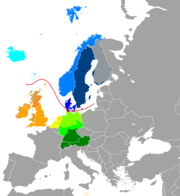German leid
Appearance
(Reguidit frae German language)
German (Deutsch, pronouncit [dɔʏtʃ]) is a Wast Germanic leid, thus relatit tae an clessifee'd alangside Inglis an Dutch. It is ane o the warld's major leids an the maist widely spaken first leid in the European Union. Globally, German is spoken bi aboot 120 million hamespun speakers an aw bi aboot 80 million non-hamespun speakers. Standard German is widely taucht in schuils, varsities an Goethe Institutes warldwide.It is a naitional leid o Germany, Austrick, Liechtenstein, Swizzerland, Luxembourg, Belgium an the European Union.
Notes
[eedit | eedit soorce]References
[eedit | eedit soorce]- ↑ Mikael Parkvall, "Världens 100 största språk 2010" (The World's 100 Largest Languages in 2010), in Nationalencyklopedin
- ↑ a b c Ammon, Ulrich (2014). Die Stellung der deutschen Sprache in der Welt (in German) (1st ed.). Berlin: de Gruyter. ISBN 978-3-11-019298-8. Retrieved 24 Julie 2015.[page needit]
- ↑ "Special Eurobarometer 386: Europeans and their languages" (PDF) (report). European Commission. Juin 2012. Archived frae the original (PDF) on 6 January 2016. Retrieved 24 July 2015.
- ↑ "Rat für deutsche Rechtschreibung – Über den Rat". Rechtschreibrat.ids-mannheim.de. Retrieved 11 October 2010.
- ↑ a b Jan Goossens: Niederdeutsche Sprache: Versuch einer Definition. In: Jan Goossens (Hrsg.): Niederdeutsch: Sprache und Literatur. Karl Wachholtz, 2. Auflage, Neumünster 1983, S. 27; Willy Sanders: Sachsensprache, Hansesprache, Plattdeutsch: sprachgeschichtliche Grundzüge des Niederdeutschen. Vandenhoeck & Ruprecht, Göttingen 1982, ISBN 3-525-01213-6, S. 32 f.; Dieter Stellmacher: Niederdeutsche Sprache. 2. Auflage, Weidler, Berlin 2000, ISBN 3-89693-326-4, S. 92.
- ↑ Nordhoff, Sebastian; Hammarström, Harald; Forkel, Robert; Haspelmath, Martin, eds. (2013). "Heich Franconian". Glottolog. Leipzig: Max Planck Institute for Evolutionary Anthropology.
- ↑ Nordhoff, Sebastian; Hammarström, Harald; Forkel, Robert; Haspelmath, Martin, eds. (2013). "Alpine Germanic". Glottolog. Leipzig: Max Planck Institute for Evolutionary Anthropology.
| Wikimedia Commons haes media relatit tae German language. |
Categeries:
- Pages uisin collapsible list wi both background an text-align in titlestyle
- German leid
- Fusional leids
- Hie German leids
- Leids o Austrick
- Leids o Belgium
- Leids o Brazil
- Leids o Denmark
- Leids o Fraunce
- Leids o Germany
- Leids o Hungary
- Leids o Kazakhstan
- Leids o Liechtenstein
- Leids o Luxembourg
- Leids o Namibie
- Leids o Romanie
- Leids o Roushie
- Leids o Swisserland
- Leids o Trentino-Alto Adige/Südtirol
- Stress-timed leids



